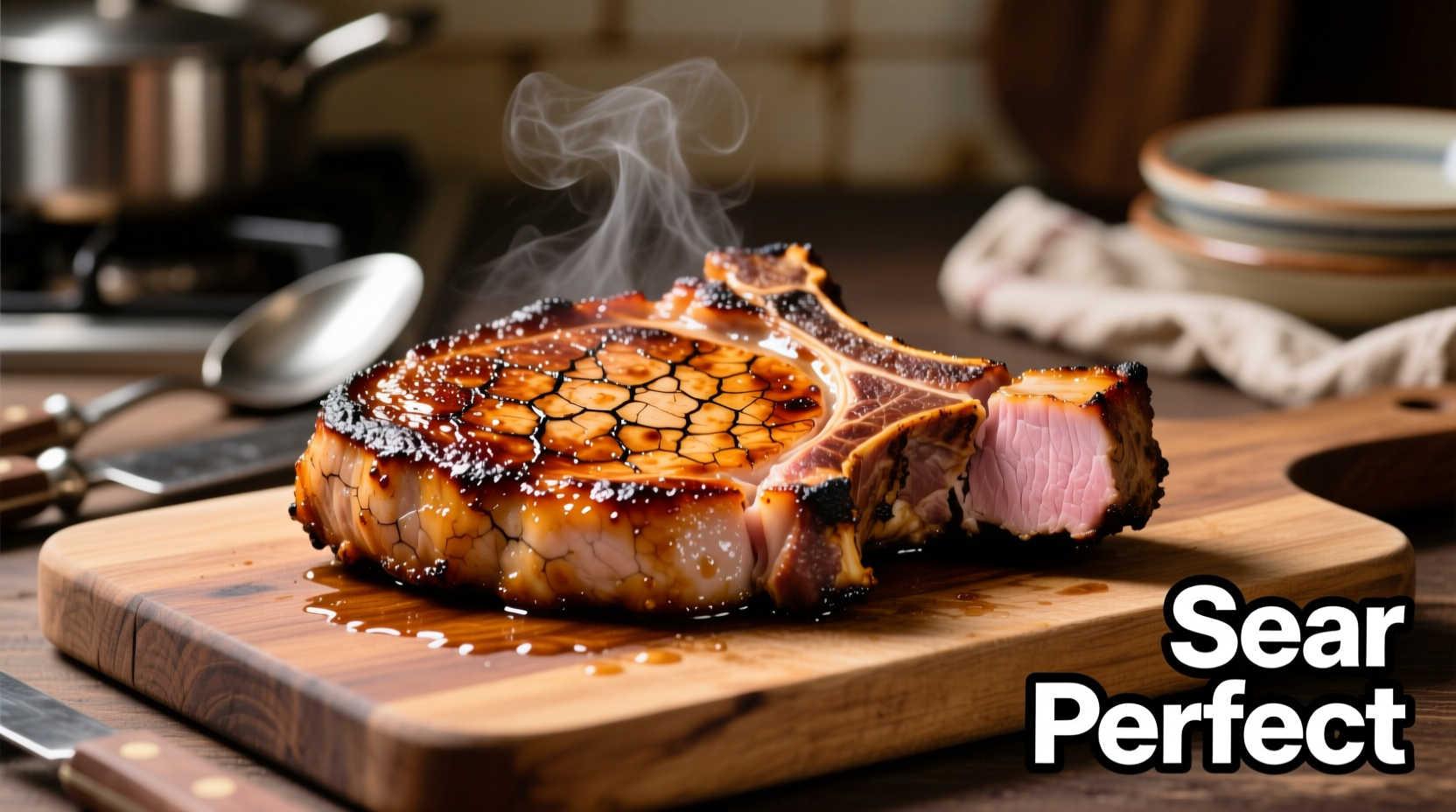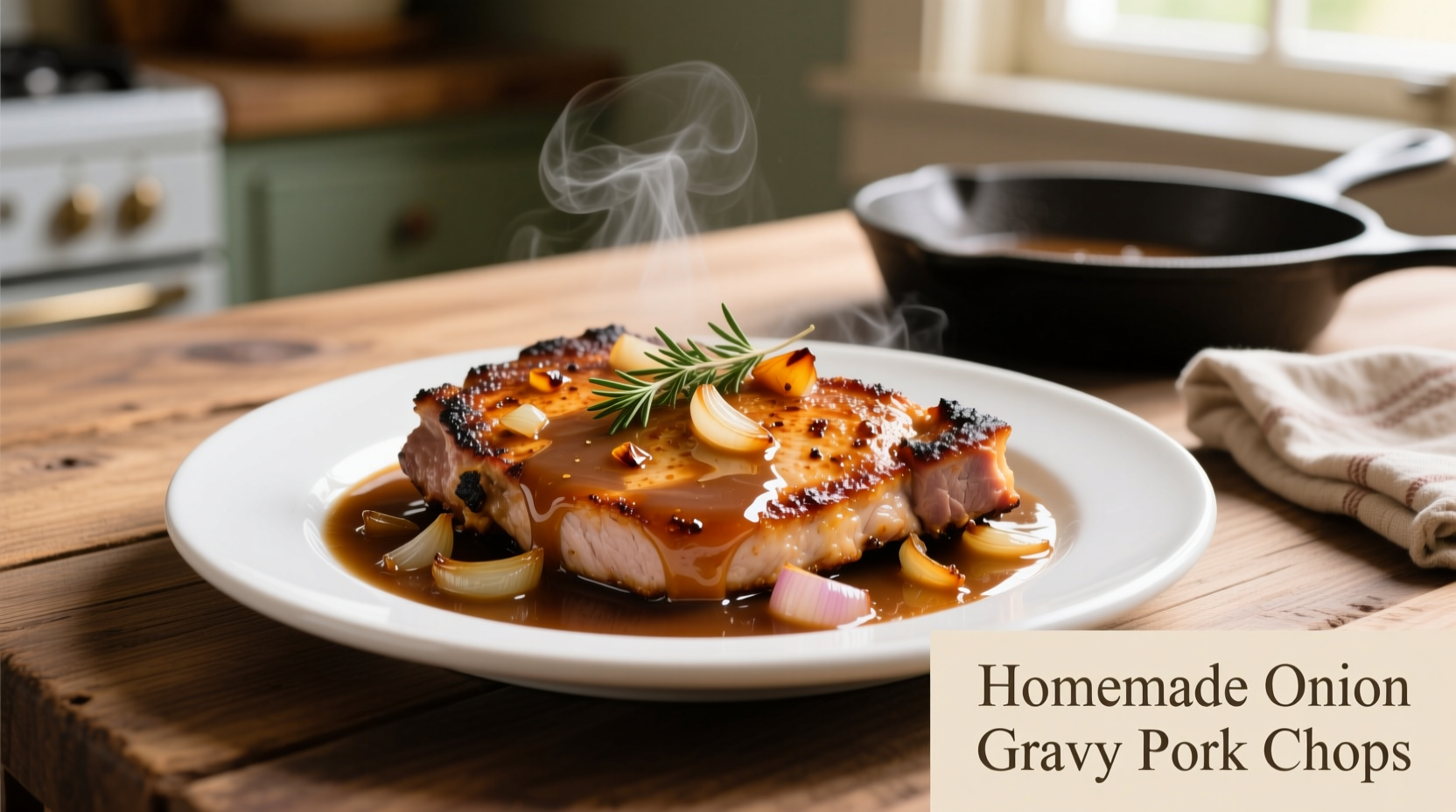The perfect pork chops with onion gravy reaches an internal temperature of 145°F (63°C) with a 3-minute rest, yielding juicy, tender meat paired with a rich, deeply flavorful onion gravy made from caramelized onions and pan drippings. This classic comfort food dish combines simple ingredients with precise cooking techniques for restaurant-quality results at home.
Mastering pork chops with onion gravy transforms a humble weeknight dinner into a culinary triumph. Forget dry, tough pork chops—this guide delivers consistently juicy results through precise temperature control and professional searing techniques. You'll learn how to build complex flavors by properly caramelizing onions and creating a velvety gravy from pan drippings, eliminating the need for store-bought mixes. Whether you're a beginner cook or looking to refine your technique, these evidence-based methods guarantee success every time.
The Essential Foundation: Selecting and Preparing Your Pork
Choosing the right cut makes all the difference in your pork chops with onion gravy. Bone-in loin chops (1¼ to 1½ inches thick) provide superior flavor and moisture retention compared to boneless varieties. The USDA Food Safety and Inspection Service confirms that properly cooked pork reaches safe doneness at 145°F with a 3-minute rest period, debunking outdated notions that pork must be cooked until well-done.
| Pork Chop Type | Best Cooking Method | Recommended Thickness |
|---|---|---|
| Bone-in loin chop | Pan-sear + finish in oven | 1¼-1½ inches |
| Boneless loin chop | Pan-sear only | 1 inch |
| Center-cut rib chop | Pan-sear + finish in oven | 1½-2 inches |
Professional Searing Technique for Perfect Pork Chops
Achieving that coveted golden-brown crust requires precise temperature management. Professional kitchens follow the "hot pan, cold oil" principle: heat your cast-iron skillet over medium-high heat for 5 minutes until properly preheated, then add oil just before cooking. This prevents oil degradation while ensuring optimal searing conditions.
Season chops generously with kosher salt 45 minutes before cooking—this allows salt to penetrate the meat rather than just seasoning the surface. Pat chops completely dry with paper towels immediately before searing; moisture is the enemy of proper browning. Sear undisturbed for 3-4 minutes per side until a deep golden crust forms, resisting the urge to move them prematurely.

Building Flavor: The Onion Gravy Transformation Process
The magic of exceptional onion gravy happens through controlled caramelization. Thinly sliced yellow onions require 25-30 minutes of patient cooking to develop their natural sugars without burning. The University of California Division of Agriculture and Natural Resources confirms that onion caramelization occurs between 212-302°F (100-150°C), a process that develops complex flavor compounds impossible to replicate with powdered substitutes.
Follow this precise timeline for perfect onion gravy:
- 0-10 minutes: Medium heat, onions release water and soften
- 10-20 minutes: Reduce to medium-low, onions turn translucent and begin browning
- 20-25 minutes: Add pinch of sugar to accelerate caramelization
- 25-30 minutes: Deep golden-brown color with rich flavor development
Creating the Perfect Pan Sauce
After removing pork chops to rest, capitalize on those flavorful pan drippings. Deglaze with 1¼ cups of low-sodium chicken broth, scraping the browned bits (fond) from the bottom of the pan—these contain concentrated flavor. Whisk in 2 tablespoons of all-purpose flour to create your roux, cooking for 2 minutes to eliminate raw flour taste.
For the richest gravy consistency, gradually whisk in 1 cup of whole milk or half-and-half. Simmer gently for 5-7 minutes until thickened to coat the back of a spoon. Season with freshly ground black pepper, a pinch of thyme, and adjust salt as needed. The American Egg Board recommends this gradual liquid incorporation method to prevent lumps and ensure smooth texture.
Avoiding Common Pitfalls
Even experienced cooks encounter challenges with pork chops with onion gravy. Understanding these limitations prevents disappointment:
- Overcrowding the pan: Causes steaming instead of searing—cook in batches if necessary
- Rushing caramelization: Onions must cook slowly to develop proper flavor
- Incorrect gravy thickness: Too thin—simmer longer; too thick—add broth incrementally
- Overcooking pork: Use an instant-read thermometer—remove at 140°F for carryover cooking
Serving Suggestions and Timing
Timing is crucial for serving pork chops with onion gravy at their peak. Rest chops for exactly 3-5 minutes after cooking—any less and juices escape, any more and they overcook. Pour warm gravy over chops just before serving to maintain optimal temperature.
Traditional pairings include:
- Mashed potatoes (absorbs gravy beautifully)
- Buttered egg noodles
- Roasted root vegetables
- Simple green salad with vinaigrette
Storing and Reheating Leftovers
Proper storage maintains quality for future enjoyment. Cool completely within 2 hours, then store pork and gravy separately in airtight containers. The USDA FoodKeeper app confirms that cooked pork remains safe for 3-4 days in refrigeration.
Reheat gently to preserve texture:
- Pork chops: 325°F oven for 10-12 minutes, covered with foil
- Gravy: Medium-low heat on stove, stirring frequently
- Avoid microwave: Causes uneven heating and rubbery texture
What's the ideal internal temperature for pork chops with onion gravy?
The USDA recommends cooking pork chops to 145°F (63°C) with a 3-minute rest period. This temperature ensures food safety while maintaining optimal juiciness. Use an instant-read thermometer inserted horizontally into the thickest part of the chop for accurate measurement.
Why does my onion gravy turn out watery?
Watery gravy typically results from insufficient roux cooking time or improper liquid ratios. Ensure you cook the flour-oil mixture for 2 full minutes before adding liquid, and maintain a 2:1 liquid-to-flour ratio. If gravy is too thin, simmer uncovered for additional 3-5 minutes to reduce, or create a slurry with 1 tablespoon cornstarch and 2 tablespoons cold water.
Can I make pork chops with onion gravy ahead of time?
Yes, but with strategic planning. Caramelize onions and make gravy up to 2 days ahead—store separately from pork. Reheat gravy gently while cooking chops fresh. Never fully cook pork chops in advance, as reheating causes toughness. The gravy component actually improves with overnight resting as flavors meld.
What's the best pan for making pork chops with onion gravy?
A heavy-bottomed cast-iron skillet provides superior heat retention for perfect searing and seamless transition from stovetop to oven if needed. Stainless steel works well too, but avoid non-stick pans which prevent proper fond development essential for flavorful gravy. Ensure your pan is large enough to avoid overcrowding—typically 12 inches for 4 chops.











 浙公网安备
33010002000092号
浙公网安备
33010002000092号 浙B2-20120091-4
浙B2-20120091-4